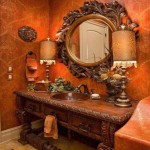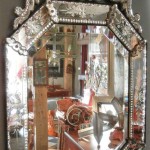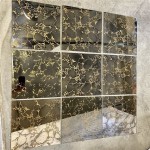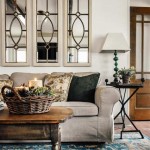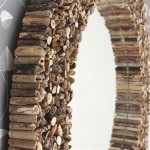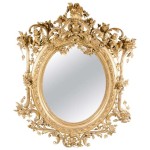18th Century Mirrors
Mirrors in the 18th century transitioned from objects of luxury accessible only to the wealthy elite to more widely available decorative and functional items. This period witnessed significant advancements in mirror manufacturing, impacting both the size and affordability of mirrors, and influencing their evolving role in interior design and social life.
The early 18th century saw the continued dominance of Venetian glassmakers in mirror production. Venice held a near-monopoly on the creation of high-quality mirrors, employing a secretive process involving mercury-backed glass. This technique, while effective in creating reflective surfaces, was both complex and hazardous. The resulting mirrors were often small and expensive, reserved for the aristocracy and the upper levels of the merchant class. These mirrors frequently featured elaborate frames crafted from gilded wood, tortoiseshell, or ebony, reflecting the opulent tastes of the period.
As the demand for mirrors grew throughout Europe, other nations sought to break Venice's stranglehold on the market. France, in particular, made significant strides in mirror manufacturing. The establishment of the Royal Glass Manufactory of Saint-Gobain in 1665 marked a turning point. This royal initiative aimed to rival Venetian production and supply the growing needs of the French court and burgeoning middle class. The development of the "casting" method, pouring molten glass onto large flat tables, allowed for the creation of significantly larger sheets of glass than previously possible. This innovation drastically reduced the cost of production and paved the way for wider mirror ownership.
The increase in mirror size had a profound impact on interior design. Large wall mirrors became a staple of grand houses and palaces, reflecting light and creating an illusion of spaciousness. This was especially significant during the Rococo period, known for its light, airy, and ornate aesthetic. Mirrors were strategically placed to maximize the reflection of candlelight, illuminating rooms and highlighting the intricate details of the decor. They were often incorporated into elaborate wall paneling, becoming integral elements of the overall design scheme.
Beyond their functional purpose of reflection, 18th-century mirrors served symbolic and decorative roles. They were frequently used in furniture design, incorporated into dressing tables, console tables, and overmantles. The use of mirrored glass added a touch of glamour and elegance to these pieces, further enhancing their appeal. Pier glasses, tall narrow mirrors designed to be placed between windows, became increasingly fashionable. These mirrors not only amplified natural light but also provided opportunities for reflection and self-adornment.
The increasing availability of mirrors also influenced social behavior. The ability to see one's own reflection became more commonplace, leading to a heightened awareness of personal appearance and the development of more elaborate grooming rituals. Mirrors played a role in the performance of identity, allowing individuals to curate and project their desired image. They also became important tools for artists, providing new perspectives and facilitating self-portraiture.
The styles of mirror frames evolved throughout the 18th century, reflecting the prevailing artistic trends. Early 18th-century frames often featured heavy ornamentation and elaborate carving, consistent with the Baroque style. As Rococo gained popularity, frames became lighter and more asymmetrical, incorporating motifs such as shells, flowers, and foliage. The latter part of the century saw the rise of Neoclassicism, with frames exhibiting a renewed interest in classical forms and greater simplicity in design.
The materials used in frame construction varied depending on the intended market. While wealthy patrons could afford frames made from precious metals and exotic woods, less expensive options utilizing painted wood or gesso became available for the growing middle class. This diversification of materials and styles made mirrors accessible to a broader segment of society, solidifying their place as both decorative and functional objects in everyday life.
The development of mercury-free mirror production methods towards the end of the 18th century further propelled the democratization of mirror ownership. While these early attempts were not always successful, they laid the groundwork for the advancements in mirror making that would characterize the 19th century.
The 18th century witnessed significant transformations in the world of mirrors. From exclusive luxury items to increasingly common household objects, mirrors reflected not only images but also the evolving social, economic, and artistic landscape of the period. Their increasing availability and affordability, coupled with their adaptability to various interior design styles, cemented their enduring presence in homes and public spaces alike.
The study of 18th-century mirrors offers valuable insights into the material culture and social dynamics of the period. From the elaborate frames of the aristocracy to the simpler designs available to the burgeoning middle class, these reflective surfaces provide a glimpse into the aesthetic preferences, technological advancements, and evolving consumption patterns of a transformative era.

Pair Of Italian 18th Century Wood Gilt Mirrors French Antique

18th Century French Regence Carved Giltwood Wall Mirror With Ornate Pediment Country Interiors

A Grand 18th Century Louis Xv Period Giltwood Parcloses Mirror Circa 1745 Anton Venoir Interiors

18th Century Antique French Style Mirrors Frames For Tagged Scroll Work Helen Y Antiques

A Pair Of 18th C Italian Baroque Mirrors Yew Tree House

French Louis Xvi Late 18th Century Giltwood Mirror With Liberal Arts Motifs For At 1stdibs Mirrors

Pair Of Italian 18th Century Giltwood Mirrors Legacy Antiques

18th Century Gilded Mirror With Scallop S

18th Century Antique Neoclassical Mirror Chairish
18th Century Italian Carved And Gilt Mirror Anthony Scornavacco Antiques

